From the Istanbul protests of Gezi Park in 2013 to the Euromaidan in Ukraine, from the cost of living protests in Israel to the Arab Spring in 2011, or the demonstrations in the streets of the Georgian capital Tbilisi, social media and smartphones have been crucial tools. They've been used to call people to action, gather crowds, mobilise movements and spread information about some of the biggest mass protests in recent history.
Now - let's rewind the clock. It's 1989 and the digital revolution is still a distant dream. No World Wide Web, no Twitter, no Facebook. Smartphones? A thing of science fiction. But on this day, the 23rd of August, something extraordinary is about to happen.
Imagine a human chain stretching 675 kilometres, linking three Baltic capitals. Nearly two million people, hand in hand, standing in perfect synchronisation. For 30 minutes, they form an unbroken line of humanity from Tallinn to Riga to Vilnius: not to set a world record, but to change the course of history.

A late summer evening in 1989.
August 23, 1989: It's Wednesday, a warm, sunny day in late summer. The days are long in this part of Europe, but they shorten quickly from August onwards. At seven in the evening, the light is still beautiful and warm. People are usually home for dinner by then—but not tonight.
The streets buzz with activity: cars line up in columns, rushing to their assigned places; rusty bicycle wheels squeak as people use any means available to reach their designated spots.
Half an hour before the human chain is to form, walkie-talkies crackle with voices of organizers and demonstrators, while portable radios, tuned to the station that will signal the moment to join hands, fill the air with anticipation.
At 7 p.m., a trilingual song—Lithuanian, Latvian, Estonian—composed for the occasion, echoes simultaneously from radio stations across the three countries: "The Baltics are waking up!"
This coordinated broadcast marks the moment for people to join hands, forming the human chain that spans the Baltic countries.
The organizers— the so-called People's Fronts established across the Baltics in the '80s—had communicated the demonstration in advance to local authorities, police, and crucially, to international journalists.
Above, some small planes and helicopters circle, recording the event. On the ground, anyone with a camera captures the historic moment.

Scattered across the internet, countless images tell the story. Some are deeply moving: young women wearing traditional Baltic flower crowns, elderly ladies tired but determined to be present, farmers clasping hands with city academics, and children everywhere.
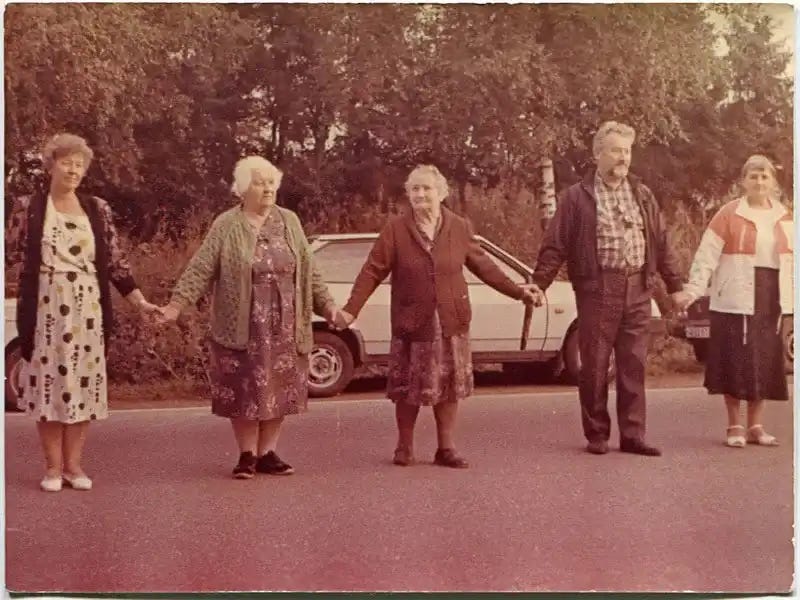
And the flags—the historic flags of the three countries, long prohibited by the Soviet Union. Latvia's flag, with its three horizontal stripes of red-white-red, had been hidden for half a century in attics, drawers, and under farmhouse floorboards. A carpenter from the countryside near Riga recalled:
"I still remember how I got the flag from my parents' house on the morning of 23 August 1989. My father had hidden it in the horse stable, in a double loft. During the Soviet era, he would have been in hot water if anyone had discovered them. You can't imagine what an uplifting feeling that was: at last we could show them openly again. We then held up the flag together: three generations: My father, me and my son."
Many participants were unaware that the Kremlin had banned the peaceful demonstration that morning. Others knew, but were not discouraged: perhaps worried, but invigorated by the presence of so many people. The Balts stood hand in hand along the 650-kilometre chain that stretched from the foot of Toompea in Tallinn to Vilnius, through Riga and across the Daugava River.
For 15 minutes, one in every four inhabitants of the Baltic Republics was there - almost two million people. There was strength in numbers: how could the authorities arrest them all? How could they disperse such a crowd? And so the human chain that made headlines around the world was created. But why on 23 August 1989? What was so significant about that date?
The Molotov-Ribbentrop Pact.
The Baltic Way, also known as the Baltic Chain, was organized to draw the world's attention to the Molotov-Ribbentrop Pact – one of modern history's most brutal and cynical backroom deals.
This secret agreement, made on August 23, 1939, by Adolf Hitler and Joseph Stalin, aimed to divide Eastern Europe between them on the eve of World War II.
In the secret protocols accompanying the non-aggression treaty, the two totalitarian powers divided Finland, Estonia, Latvia, Lithuania, Poland, and Romania – in violation of international law – into their respective spheres of influence.
This paved the way for Nazi Germany to start World War II with its attack on Poland on September 1, 1939. The first paragraph of the secret protocols stated:
"Für den Fall einer territorial-politischen Umgestaltung in den zu den baltischen Staaten (Finnland, Estland, Lettland und Litauen) gehörenden Gebieten bildet die nördliche Grenze Litauens zugleich die Grenze der Interessensphären Deutschlands und der UdSSR."
"In the event of a territorial-political reorganization in the areas belonging to the Baltic states (Finland, Estonia, Latvia, and Lithuania), the northern border of Lithuania shall simultaneously form the border of the spheres of interest of Germany and the USSR."
Less than a year later, on June 16, 1940, the Soviet Union invaded Estonia and Latvia, stripping them of their national identities and forcibly incorporating them into the U.S.S.R. Lithuania was later added to the Soviet sphere of interest. Stalin's secret police swiftly murdered many Baltic government, business, and cultural leaders. Thousands of others were sent to the Soviet Gulag prison system east of the Ural Mountains.
At the end of the 1980s, the effects of the Molotov-Ribbentrop Pact were still keenly felt in the Baltic states. The occupation continued, but the USSR denied the Pact's existence and insisted that the Baltic states had voluntarily joined the Soviet Union.
During the 50-year occupation, Moscow not only deported many Lithuanians, Latvians, and Estonians to the Urals, Siberia, and Kazakhstan but also imported numerous Russian workers to the Baltic republics to work in industrial complexes and factories. In Latvia, this demographic shift was so dramatic that the original Latvian population fell below 50 percent, outnumbered by Russians.
With the human chain of August 23, 1989, the inhabitants of the three Baltic states primarily demanded public acknowledgment of the Pact's secret protocols. This would inevitably lead to reclaiming their independence, as almost nobody in these countries felt like a Soviet citizen.
"I never felt like a Soviet citizen. It wasn't always easy. In Riga, in some shops, if you ordered something in Latvian – the shop assistant answered you in Russian. Because she didn't know Latvian. Or she didn't feel like speaking it. That was humiliating! But it only strengthened my identity: I am Latvian!."
Valentina Kuopmanis, a Latvian participant in the protest.
Organizing such a massive demonstration on August 23, 1989, was a point of no return. The mere idea would have frightened even the most ardent national activists.
Local movements had already organized events in previous years – in 1986, 1987, and 1988 – to remember the Victims of the 1941 Deportations. These events didn't always go smoothly; in 1987, strong conflicts with the police arose in Riga and Vilnius, resulting in the detention of several hundred people. Planning something of this magnitude seemed almost crazy. Yet, remarkably, only five weeks passed from the initial idea to the event itself.
From idea to execution.
Who came up with the idea of the human chain? Check sources, ask around: Nobody knows for sure. At the time, the People's Fronts had been established throughout the Baltic States for about a year. They were meeting regularly, although the whole organisation was far from stable.It was a movement that was well-rooted but also involved in constant discussions and debates, internal rivalries and competition.
The front was simply too big to be unanimous, encompassing everyone from "good communists" at one end - to ultra-radical dissidents at the other. In the summer of 1989 they set up the International Baltic Council to coordinate among themselves.
It's said that the idea was born within the Estonian People's Front, and then shared with the others - the Latvian People's Front and the Lithuanian Reform Movement, Sąjūdis - at a meeting in Pärnu, now a popular summer resort near the Latvian border.
When? That's the surprise: on 15 July, just five weeks before 23 August. And remember - under fear of Soviet surveillance, without internet or smartphones. All the planning and coordination was done by landline phone and word of mouth.
From then on, all subsequent meetings were held in secluded locations, reached by back roads to prevent anyone from following them.
From the start, the biggest concern was whether there would be enough people to link the chain. So, they did the maths: one person could cover about 1.5 metres with their arms outstretched. So, the route from Vilnius through Riga to Tallinn would require at least 400,000 people to cover the 600km distance. That's over 100,000 from each country. The route was also changed during the planning phase, resulting in a longer route of almost 700 km. That meant they needed at least half a million people.
Then the press work began. After all, it wasn't so much about surprising the world as it was about being seen. In all, about ten people coordinated the route and assembly with the authorities, met with local police traffic departments (as traffic had to be restricted across the Baltic region, on a Wednesday!), informed the press, arranged visas and accreditation for foreign media and, of course, coordinated the event so that people were evenly distributed along the entire chain.
On the ground, one person per kilometre was appointed as a logistics coordinator. Their job? To make sure there were enough people and that they were evenly distributed. Where there weren't enough hands, they used flags and belts or even jacket sleeves. Some of the photos show the creative solutions used to fill the gaps.
But the gaps to bridge, it must be said, were rather small: there were almost 2 million people on that day. That's enough to make your eyes pop out of your head.
The first to be surprised were the organisers. Once the surprise wore off, a feeling of incredible power entered the minds of the organisers and participants. You know that feeling, don't you? When you do something you didn't think you were capable of... and suddenly you feel invincible. Sarmīte Ēlerte, who later became Minister of Culture of Latvia, recalled her thoughts and feelings when organizing the human chain:
"There was a feeling that nothing and no one could stop us. Not this time. There was no turning back."
A view from above.
There's an anecdote—purely fictional, of course—about NASA's space observatory on August 23, 1989. Picture the NASA staff in Houston, eyes glued to their screens. It's just another day—until a mysterious white stripe suddenly appears on the satellite images of the Soviet Union, stretching across the Baltic States. Everyone's baffled—everyone except one. A native Estonian. He knows exactly what's going on. 'What you're seeing there, dear colleagues,' he announces solemnly, 'isn't some gigantic contrail. It's a human chain. This... is the Baltic Way.
Now, let's return to reality.
In the pre-drone era, when unauthorized flights could lead to severe consequences, some of the most striking images of the Baltic Way came from above. While American journalists with greater resources managed aerial shots from planes, one local photographer's story stands out: Aivars Liepins, now a renowned visual artist from Riga, who was then working for an anti-Soviet Popular Front newspaper.
Liepins' adventure began with an unexpected phone call. In a near-empty office, a mysterious woman offered him a once-in-a-lifetime opportunity: a helicopter ride along the protest line stretching across the Baltics. The catch? He had just 15 minutes to reach the airport.
Faced with this seemingly impossible deadline, Liepins sprang into action. In a scene worthy of a Hollywood thriller, he dashed into the streets and commandeered a black Volga - a car typically reserved for communist officials. Thanks to a friendly chauffeur he knew, Liepins began to race against the clock.
Speeding through the city, ignoring red lights, they reached the airport in exactly 15 minutes. As the Volga screeched to a halt on the tarmac, Liepins, armed with two 35mm Canon cameras, ducked under the whirling helicopter blades and leapt aboard.
When the pilot asked for a destination, Liepins chose the highway stretching east from Riga towards Estonia. This split-second decision led to some of the most iconic aerial photographs of the Baltic Way, capturing the magnitude of the human chain in a way that ground-level shots simply couldn't match.
Interestingly, the helicopter had originally been hired by the Latvian National Front. However, fearing KGB reprisals, the movement's leaders had backed out at the last minute. Their nervousness inadvertently created this golden opportunity for Liepins. Someone's quick thinking to invite a photographer aboard the already-paid-for helicopter resulted in visual documentation that would resonate around the world.
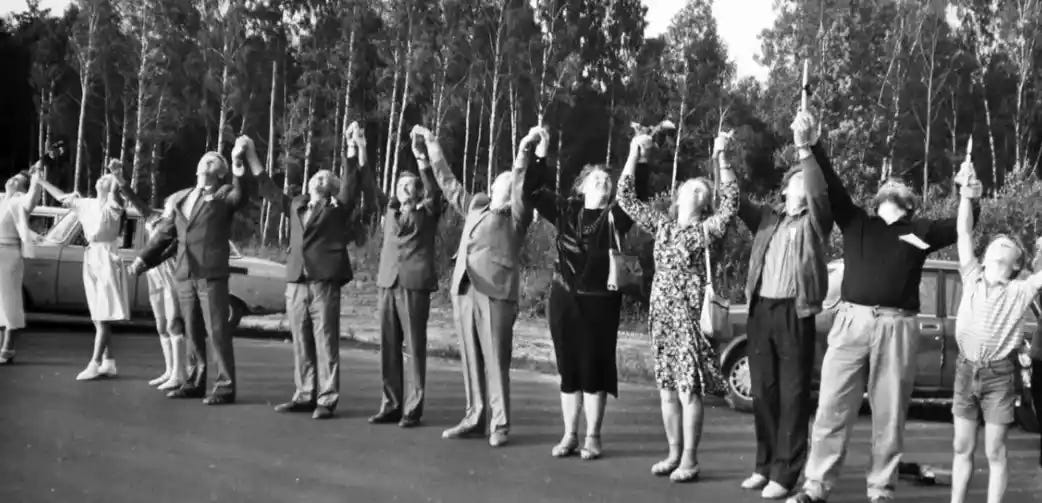
The Baltics: back on our maps.
The Baltic Way put the Estonian, Latvian and Lithuanian cause in the global headlines. It also had another effect: it put the Baltic countries back on the map and in the minds of Europeans. The final consecration, however, came with the liberalisation of low-cost airlines across the European Union - how many young people, driven by curiosity and perhaps with only a vague idea of these countries, have spent a weekend in Riga, Tallinn or Vilnius in recent years?
In 1989 I lived in Italy, near the Yugoslav border. The world was turning upside down in Poland, Hungary and even the Soviet Union, with freedom of speech, mass demonstrations, free elections and the dismantling of the Communist monopoly on power and wealth. As a politically engaged teenager, I craved news: I read everything I could, despite the absence of the World Wide Web. I even tuned in to Radio Free Europe, Washington's broadcasts to Eastern Europe, which I could hear clearly from where I was.
I had some knowledge, though limited, of the mass deportations under Soviet rule, the extermination of Jews and others during the brief Nazi occupation, the destruction of national culture, and the slow genocide caused by discriminatory housing policies that favoured Soviet migrants over locals.
But I'll be honest: I wasn't fully aware of the amazing rebirth of opposition and pro-independence sentiment in recent years. Then, suddenly, there they were on the TV news: the human chain, people waving their old national flags - which I didn't recognise - across countless miles of road.
The Soviet Union reaction and the Baltics independence.
The situation was tense. Hundreds of thousands of Soviet soldiers were stationed in the Baltic Soviet republics of Latvia, Lithuania and Estonia. From his presidential perch in Moscow, would Mikhail Gorbachev order the human chain to be broken up - perhaps even by force? Or would the Kremlin leader simply tolerate this bold act of defiance?
But nothing happened that day on the Soviet side. Three days later, on 26 August 1989, the Central Committee of the Communist Party issued a warning statement on Vremya, the main news programme on Soviet television. It read:
"Matters have gone far. There is a serious threat to the fate of the Baltic peoples. People should know the abyss into which they are being pushed by their nationalistic leaders. Should they achieve their goals, the possible consequences could be catastrophic to these nations. A question could arise as to their very existence."
The Communist Party denounced "nationalist, extremist groups" for their "anti-socialist and anti-Soviet" agenda, accusing them of discrimination and terror. They described the Baltic Way as "nationalist hysteria". It sounded threatening, but nothing dramatic happened. Moscow's tone soon softened. An internal struggle was taking place in the Politburo and in the mind of Mikhail Gorbachev.
The West's reaction was vocal but cautious. **President Bush and Chancellor Kohl argued for peaceful reform and criticised the Molotov-Ribbentrop pact. Baltic activists appealed to the UN, citing threats of aggression. The September plenum of the Communist Party reaffirmed Soviet centralisation and the dominance of the Russian language, and offered limited autonomy.
Bonn and Washington took a softer line. At the time, many believed that if Gorbachev were replaced, the USSR would descend into chaos. Many in the Baltic states still complain that their struggle for independence wasn't fully supported, and was instead seen as a threat to Gorbachev and thus to Western - particularly German - interests, represented by Helmut Kohl. Throughout these events, Germany's cautious, ambiguous relationship with the Soviet Union and Russia emerges like a karst stream - a subject worthy of its own episode. Meanwhile, from the other side of the ocean, Bush Senior was putting pressure on Gorbachev: if blood was shed in the Baltic states, he warned, the West would cut off credit. Money mattered then, as it does now.
In December 1989, a Soviet commission convened by Mikhail Gorbachev condemned the secret protocols of the Molotov-Ribbentrop Pact. In February 1990, in the first free democratic elections in all three Baltic states, pro-independence candidates won majorities.
On 11 March 1990, within seven months of the Baltic Way, Lithuania became the first Soviet state to declare independence.
It would be the perfect ending, wouldn't it? But it wasn't. What followed was the last violent attempt to restore the old Soviet order - under Gorbachev, leaving the biggest stain on his legacy.
On the night of January 12-13, 1991, Vilnius was occupied by Soviet tanks. Violent clashes broke out between the local population and the Soviet forces. Fourteen civilians were killed and more than 140 injured. 13 January was the most violent day of the month in Lithuania. Today it's remembered as the Day of the Defenders of Freedom and is officially observed as a day of remembrance.
Young Loreta Asanaviciute was among the fourteen victims. Taken to hospital, she asked her last, heartbreaking question - "Will I still be able to get married?" - before dying the same day. The image of the girl, barely twenty, her legs crushed under the tracks of tanks, circulated around the world and had a profound effect on the course of history.
By the end of 1991, most Western countries had recognised the independence of all three Baltic states.
Yesterday, today.
When you meet Lithuanians, Estonians or Latvians, you can feel it: the pride, the awareness of their own history and identity. When a people regain their freedom and independence by liberating themselves, against all odds and initially with rather tepid support from the West, the least you can do is listen to them: their stories, their fears, their motivations.
For almost three years now, old fears have been resurfacing - the Russian and Belarusian neighbours are, to use a gentle metaphor, troublesome. While from our homes we continue to flagellate ourselves with the idea that we have taken NATO too far and offended Russian sensibilities, from Riga, Tallinn and Vilnius they will reply: if we hadn't been part of NATO, we would now be like Ukraine. Probably not, who knows?
But one fact to ponder is that for systems ruled by mafia oligarchies, the real threat is not NATO military bases, but free, prosperous and happy civil societies. Because their example might give strange ideas to others - who are not free, prosperous and happy.
Lithuania, Estonia and Latvia are shining examples of how peoples can make history - when they are united, supportive of each other and able - literally - to hold hands.
The Baltic Way in pictures
Video Footage & Docs
Youtube | Baltijas Ceļš. Baltic Way. Raw footage (1 of 3)
Youtube | Baltijas Ceļš. Baltic Way. Raw footage (2 of 3)
Youtube | Baltijas Ceļš. Baltic Way. Raw footage (3 of 3)
Music credits & links
The Baltics Are Waking Up! (Lithuanian: Bunda jau Baltija; Latvian: Atmostas Baltija; Estonian: Ärgake, Baltimaad) is a trilingual song composed by Boriss Rezniks for the occasion of the Baltic Way, a large demonstration against the Soviet Union for independence of the Baltic States in commemoration of the 50th anniversary of the Molotov–Ribbentrop Pact. The song is sometimes regarded as the joint anthem of the Baltics. The Lithuanian text was sung by Žilvinas Bubelis, Latvian by Viktors Zemgals, and Estonian by Tarmo Pihlap.The version in the podcast is released for Public Domain Mark 1.0 in Lithuanian language. Listen on Youtube.
"The Daugava", also known as "Saule, Pērkons, Daugava", is a popular folk song in Latvia and Lithuania, with variations found throughout the Baltic States. The ballad tells the story of three sisters - Saule (the sun), Pērkons (the thunder) and Daugava (the river) - who wake up by the sea and go their separate ways. A version with English subtitles can be found on YouTube. A stirring version was performed at the Latvian Song Festival in 2018:
Music tapestry: I rely on the Ukrainian musician Serge Pavkin and his ready-made, fully licensed tracks. Please visit SergePavkinMusic on Youtube and his Spotify account.
ALSO TO REMEMBER Inspired by the 1989 Baltic Way, thousands of Hong Kong residents formed a human chain stretching across the city on August 23, 2019. An Estonia-based Hongkonger proposed organizing a similar demonstration on the Hong Kong online forum LIHKG in August 2019. Less than a month after the proposal, a 60 km human chain was formed with the participation of more than 210,000 Hong Kong residents.




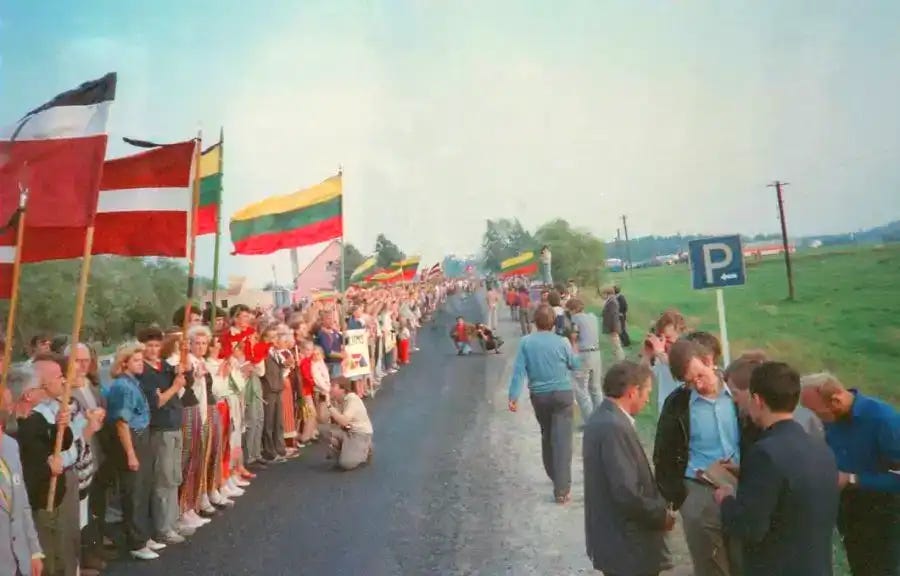


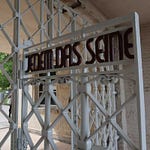
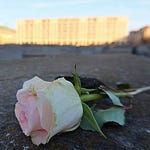




Share this post